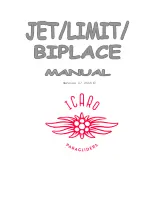
26
8.8 Cross Wind Landing and Take Off
Pilots with less experience should avoid landing or taking off with high crosswind components, as skills
do not always match the capabilities of the ultralight. Crosswind landing or take off with low wind
components up to 1 m/s are quite safe and controllable, even to the inexperienced pilot.
The nominated approach speed of 51 km/h
should be increased to 60 km/h when landing in cross wind
conditions of 5m/s or more.
After touchdown in cross wind conditions the relative airflow over the wing will become increasingly span
wise (From tip to tip) as the ultralight slows down. The upwind tip should be lowered slightly (the amount
depends on the wind strength), and the undercarriage wheels will retain firm contact with the ground.
Take off procedure is unchanged for the nominated crosswind limit. The upward may need to be lowered
at the start of the take off procedure in higher cross winds.
8.9 Go-Around Landing
During a situation where a go-around landing is required, normal take off power and procedures should
be used.
8.10 Stopping the Engine
To stop the engine after a period of running, the ignition should be switched off at idle. If the engine has
been running under full power, allow the engine to cool at idle before switching off.
8.11 After Landing / Securing
After landing and when in the parking switch the ignition off and set the key in off position. The ultralight
should be parked in a crosswind position with the base tube secured to the mast brace. The rescue
system safety pin should be inserted before leaving the ultralight.
9. LANDING GEAR OPERATION
Please, bear in mind that the main purpose of the retractable landing gear on the ANT trike is significant
reduction in the dimensions of the folded in transport position trike. The drag reduction from retracted
landing gear is fairly small and it won’t be noticeable in flight.
The in-flight landing gear retraction and extension procedures are similar to those described in the
section 3.3. Retractable landing gear. The only difference is that the pilot will be sitting in the seat and
piloting the trike which will make it less comfortable to operate the undercarriage.
WARNING
PRIOR ATTEMPTING THE LANDING GEAR RETRACTION IN FLIGHT, TRAIN DOING THIS PROCEDURE ON
THE GROUND FROM THE PILOT SEAT. SECURE THE TRIKE IN LIFTED POSITION BEFORE TRAINING.
WARNING
DON’T FORGET TO EXTEND THE LANDING GEAR BEFORE LANDING.
10. EMERGENCY PROCEDURES
10.1 General
This section contains operating procedures for flight and system emergency conditions that are essential
for the continued safe operation of the ultralight.
Always maintain correct airspeed and altitudes in the circuit area.
Summary of Contents for ANT
Page 2: ...2...









































